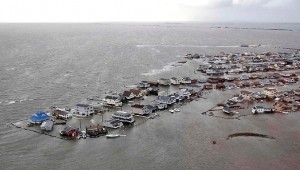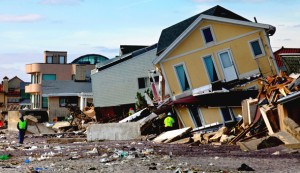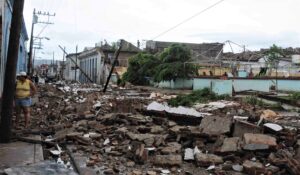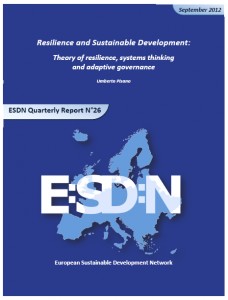2013-01-13: The 13th … a lucky day !
As we drive harder and deeper (at least some of us anyway ?) towards a future of Sustainable Human & Social Development … or are forcefully driven by the anthropogenic (man-made) pressures of Resource Shortages (e.g. water – food – energy) and Climate Change, in the case of millions of people living in poverty throughout the world … or are dragged screaming, which I fear will have to be the solution with the privileged classes in every society who are addicted to lavish and wasteful lifestyles and who show absolutely no interest in either Climate Change or Resource Shortages until they rear up and bite them in the ass (!!) … there is a desperate need for a more complex and precise language of Sustainability, which will give shape to the innovative trans-sectoral concepts and trans-disciplinary policy and decision-making support tools required for Tangible/’Real’ Sustainability & Climate Resilience Implementation.
At the time of writing, the Principal Challenge before us is …
Transforming Social Organization … the Ultimate Goal being to arrive quickly at a dynamic and harmonious balance between a Sustainable Human Environment and a flourishing, not just a surviving, Natural Environment … with the Overall Aim of achieving Social Wellbeing for All.
.
Climate Change did not directly cause Hurricane Sandy, a severe weather event which hit the Caribbean and the East Coast of the USA during October 2012 … but it was a significant contributing factor. Scenes like those in the photograph below will be experienced far more frequently in the future.
This is not Manhattan, in New York City … so, is the development shown below to be removed altogether … or renewed with the necessary and very costly construction of a massive system of flood protection measures ? Not an easy choice. Which choice would be more sustainable ?
However … WHEN, not IF … Average Global Temperatures rise above 1.5 degrees Celsius, many Small Island Developing States (SIDS) will suffer a similar fate … permanently …

.
The Type of Lightweight Development in the foreground of the photograph below … damaged beyond repair or re-construction during Hurricane Sandy, is not Resilient … which is a different concept to Robust, or Robustness.
Notice the building in the background, on the left, which appears to have survived fully intact … why ??

.
In complete contrast … the Type of Development, below, is more Resilient. Furthermore, however, as a normal human reaction to decades of aggressive, but ultimately unsuccessful, political bullying and economic assault by the USA, the Social Fabric of Cuba is very strong … making this a Resilient Human Environment …

.
So … what is a Resilient Human Environment … particularly in the context of Sustainable Climate Change Adaptation ?
What do we mean by Transforming Social Organization ??
And … as we drive forward, harder and deeper … why is it critical that we practice a balanced, synchronous approach … across ALL Aspects of Sustainability … to Tangible Sustainability & Climate Resilience Implementation ???
Let us confront some more interesting new words and thought-provoking concepts …
.
European Sustainable Development Network
2012 – ESDN Quarterly Report Number 26 – Umberto Pisano, Author
Click the Link Above to read and/or download a PDF File (2.17 Mb)
.
Abridged Executive Summary
The term resilience originated in the 1970’s in the field of ecology from the research of C.S.Holling, who defined resilience as ‘a measure of the persistence of systems and of their ability to absorb change and disturbance and still maintain the same relationships between populations or state variables’. In short, resilience is defined as ‘the ability of a system to absorb disturbances and still retain its basic function and structure’, and as ‘the capacity to change in order to maintain the same identity’.
Resilience can best be described by three crucial characteristics: (1) the amount of disturbance a system can absorb and still remain within the same state or domain of attraction; (2) the degree to which the system is capable of self-organization; and (3) the ability to build and increase the capacity for learning and adaptation.
In the need for persistence, we can find a first connection with sustainable development. Sustainable development has the objective of creating and maintaining prosperous social, economic, and ecological systems. Humanity has a need for persistence. And since humanity depends on services of ecosystems for its wealth and security, humanity and ecosystems are deeply linked. As a result, humanity has the imperative of striving for resilient socio-ecological systems in light of sustainable development.
Resilience thinking is inevitably systems thinking at least as much as sustainable development is. In fact, ‘when considering systems of humans and nature (socio-ecological systems) it is important to consider the system as a whole. The human domain and the biophysical domain are interdependent’. In this framework where resilience is aligned with systems thinking, three concepts are crucial to grasp: (1) humans live and operate in social systems that are inextricably linked with the ecological systems in which they are embedded; (2) socio-ecological systems are complex adaptive systems that do not change in a predictable, linear, incremental fashion; and (3) resilience thinking provides a framework for viewing a socio-ecological system as one system operating over many linked scales of time and space. Its focus is on how the system changes and copes with disturbance.
To fully understand resilience theory, the report focuses therefore on the explanation of a number of crucial concepts: thresholds, the adaptive cycle, panarchy, resilience, adaptability, and transformability.
As shown, humanity and ecosystems are deeply linked. This is also the fundamental reason why to adopt the resilience-thinking framework is a necessity for governance. The resilience perspective shifts policies from those that aspire to control change in systems assumed to be stable, to managing the capacity of socio–ecological systems to cope with, adapt to, and shape change. It is argued that managing for resilience enhances the likelihood of sustaining desirable pathways for development, particularly in changing environments where the future is unpredictable and surprise is likely.
This exposes the strong need for Sustainable Development Governance to embrace resilience thinking. It is not only about being trans-disciplinary and avoiding partial and one-viewpoint solutions; what is needed to solve today’s problems – and especially those linked to sustainable development – is a new approach that considers humans as a part of Earth’s ecosystems, and one in which policies can more effectively cope with, adapt to, and shape change.
In this scenario, the concept and key characteristics of so-called adaptive governance seem to be a practical means for societies to deal with the complex issues that socio-ecological systems are confronted with. Therefore, adaptive governance is best understood as an approach that unites those environmental and natural resource management approaches that share some or all of the following principles: polycentric and multi-layered institutions, participation and collaboration, self-organization and networks, and learning and innovation. Additionally, four interactive crucial aspects for adaptive governance are suggested: (1) to build knowledge and understanding of resource and ecosystem dynamics; (2) to feed ecological knowledge into adaptive management practices; (3) to support flexible institutions and multilevel governance systems; and,(4) to deal with external disturbances, uncertainty, and surprise. Therefore, nine values toward a resilient world are also suggested: diversity, ecological variability, modularity, acknowledging slow variables, tight feedbacks, social capital, innovation, overlap in governance, and ecosystem services.
Finally, three examples analyse practical instances in terms of resilience: (1) the approach taken by the so-called climate change adaptation discourse; (2) the Kristianstad Water Vattenrike, a wetland in southern Sweden that showed problems with loss of wet meadows, decline of water quality, and a disappearing wildlife habitat; and 3) the Goulburn-Broken Catchment from the State of Victoria (Australia). Some lessons can be drawn from these three cases. From the first case, governance structures have direct implications for the level of flexibility in responding to future change as well as variation in local contexts. Sensitivity to feedbacks relates both to the timing as well as where these feedbacks occur. Therefore, learning is more likely if feedbacks occur soon relative to action, and if those most affected by feedbacks are those responsible for the action. Additionally, the way in which a problem is conceptually framed determines the way in which responses are identified and evaluated and therefore influences the range of response characteristics. Second, the example from Sweden revealed that (a) the imposition of a set of rules to protect an ecosystem from the outside will not ensure the natural qualities of a region will be preserved over time. One size never fits all, and an understanding of local history and culture needs to be integrated into the management if local values are to be looked after; (b) for an organization to meaningfully deal with complexity at many scales, it needs to include representatives from each of these levels in the social network; (c) several organizations need to be prepared to contribute to a shared vision and build consensus and leadership – crucial components in adaptability and transformability. Third, the Goulburn-Broken story demonstrates the critical importance of understanding the underlying variables that drive a socio-ecological system, knowing where thresholds lie along these variables, and knowing how much disturbance it will take to push the system across these thresholds.
.
.
END


